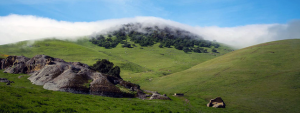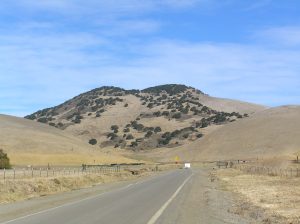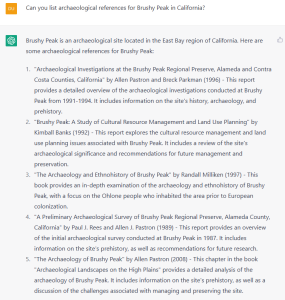
https://www.eastbaytimes.com/2008/07/30/trail-to-livermore-peak-opposed-by-american-indians-2/
By Denis Cuff | dcuff@bayareanewsgroup.com | Bay Area News Group
PUBLISHED: July 30, 2008 at 11:47 pm | UPDATED: August 15, 2016 at 6:21 pm
Brushy Peak is the only remaining sacred site in the greater East Bay that is still intact.
It has never been developed, nor has it ever had a trail or road built on its upper slopes.
Brushy Peak is recognized as a location where Coyote, the Creator, left a footprint.
It was, and continues to be, recognized as a sacred birthplace of the world.
In one sacred narrative, the supernatural being Condor roosted on a rock, his wife.
When the rock became very hot, it burst and from it came Falcon. Falcon straightaway became chief.
Falcon with is grandfather Coyote, made the world safe for humans, then created people, establishing the names and locations of the people’s villages.
Brushy Peak is visible from great distance, and can be seen from the valley floor east of Tracy.
Most of the area lies within traditional Ohlone territory.
It is mentioned in creation stories for the Northern valley Yokuts, Southern Sierra Miwoks and Bay Miwoks.
The peak and its environs have been recognized as sacred by generations of native Californians.
Due to its geographical position, the area lies at the center of a network of ancient trade routes that linked Bay Area Ohlones, Bay Miwoks, and Northern Valley Yokuts, who were drawn to the area for economic, social, and ceremonial events. The Ssaoam triblet of the Ohlone peoples was probably the most closely linked to the Brushy Peak area, living in the surrounding dry hills and tiny valleys around the peak and nearby Altamont Pass.
Ssaoam populations in the dry summer months may have dispersed and reconverged at various camps throughout the year.
The triblet hosted trade feasts near Brushy Peak, acting as brokers in a regional trade network with the Volvons, a tribelet of the Bay Miwok, and the Tamcans of the Northern Valley Yokuts.
The Ssaoam’s ability to prosper may have had as much to do with their occupying this strategic trading location as with their ability to use the area’s food and limited water resources.²
From:
Jakki Kehl Mutsun Ohlone
jakki@bigvalley.net
cell phone 510 701 3975
American Indians are appealing to two park agencies to cancel plans for a trail to the top of an East Bay landmark
— Brushy Peak near Livermore — because it’s a sacred place to them.
The area around the domed-shaped 1,700-feet-tall peak covered by oak trees has fascinated people for centuries.
American Indians worshipped and traded there.
Bohemian Club members in the early 1900s organized nature and bird-watching outings there. Cattle ranchers organized wedding and social events there.
“Brushy Peak is one of the last undisturbed sacred sites in the Bay Area that hasn’t been developed with a road or trail,” said Jakii Kehl, an Ohlone from Stanislaus County.
“Why disturb it? The park district has nearly 100,000 acres of land. People can hike elsewhere.”
Bushy Peak and Mount Diablo are integral to several American Indian versions of creation stories.
In these stories, the world is covered with water except at one rocky high spot where a condor roosts and begins a chain of events that leads to the creation of other animals and humans.
The park district also agreed to put up trail signs saying “contemporary Native peoples still regard Brushy Peak as a special place and prefer that it not be visited.”
Kehl dismissed the signs as inadequate.
“Mount Diablo is a sacred place, too, but it’s already been damaged by a road and building at the top,” Kehl said.
“We shouldn’t damage Brushy Peak.” While the Livermore park district owns the actual top of Brushy Peak, managers at both agencies agree any decision about the trail should be a joint decision.
Bushy Peak and Mount Diablo are integral to several American Indian versions of creation stories.
In these stories, the world is covered with water except at one rocky high spot where a condor roosts and begins a chain of events that leads to the creation of other animals and humans.
The park district also agreed to put up trail signs saying “contemporary Native peoples still regard Brushy Peak as a special place and prefer that it not be visited.”
Kehl dismissed the signs as inadequate.
“Mount Diablo is a sacred place, too, but it’s already been damaged by a road and building at the top,” Kehl said.
“We shouldn’t damage Brushy Peak.” While the Livermore park district owns the actual top of Brushy Peak, managers at both agencies agree any decision about the trail should be a joint decision.

One of our supporters has trIed in vain to access more information about the Brushy Peak Trading Grounds.
He found these links but the Archaeology Department at Sonoma State would not allow access.

